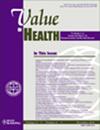希望在癌症治疗中的价值:癌症患者和普通大众的风险偏好和异质性。
IF 6
2区 医学
Q1 ECONOMICS
引用次数: 0
摘要
目的:量化希望在癌症治疗中的价值,并检验年龄作为一个潜在的修饰因素,比较患者和公众。方法:于2024年对426名近5年内确诊的韩国癌症患者和2048名没有癌症经历的普通民众进行离散选择实验。选择选项包括治疗效果、健康状况和自付费用。治疗效果包括一个固定的2年生存选项和四个风险选项,提供10%的延长生存机会(5年或10年)和10%的最低生存机会(3个月或1年),剩余80%的生存时间不同,以产生相同的预期生存。每个参与者完成10个选择任务,在假设的5岁和70岁的年龄重复。进行混合logit和潜在类分析(LCA)。结果:两组患者,尤其是癌症患者,对10年和1年生存率均为10%的治疗给予积极评价。对患者来说,这种选择的希望价值是12,445美元,大约是普通公众(5,985美元)的两倍。对于5岁的人来说,这两个数字分别增加到51103美元和35609美元,但对于70岁的人来说,这个数字要低得多。相反,确定性选择比5年和3个月生存率为10%的治疗更受欢迎。LCA显示了显著的偏好异质性。结论:希望的价值代表了治疗偏好的一个有意义的方面,特别是在儿科环境中。然而,巨大的偏好异质性对有效地将“希望”纳入卫生技术评估提出了挑战,特别是在公共资助的卫生保健系统中。本文章由计算机程序翻译,如有差异,请以英文原文为准。
The Value of Hope in Cancer Care: Risk Preference and Heterogeneity in Cancer Patients and the General Public
Objectives
To quantify the value of hope in cancer care and examine age as a potential modifier, comparing patients and the general public.
Methods
A discrete choice experiment was conducted in 2024 with 426 cancer patients diagnosed within the past 5 years and 2048 general public members without prior cancer experience in South Korea. Choice options comprised treatment effects, health status, and out-of-pocket costs. Treatment effects included a fixed 2-year survival option and 4 risk options offering 10% chances of extended survival (5 or 10 years) paired with 10% chances of minimum survival (3 months or 1 year), with varying survival durations for the remaining 80% to yield the same expected survival. Each participant completed 10 choice tasks, repeated for hypothetical ages of 5 and 70. Mixed logit and latent class analyses were performed.
Results
Both groups, particularly cancer patients, positively valued treatments with 10% chances of 10-year and 1-year survival over certainty. The monetary value of hope for this option was $12 445 for patients, about double that for the general public ($5985). These values increased to $51 103 and $35 609, respectively, for age 5, but were much lower for age 70. Conversely, the certainty option was preferred over treatments with 10% chances of 5-year and 3-month survival. Latent class analyses revealed substantial preference heterogeneity.
Conclusions
The value of hope represents a meaningful aspect of treatment preferences, especially in pediatric contexts. However, substantial preference heterogeneity poses challenges to effectively incorporating hope into health technology assessments, particularly in publicly funded healthcare systems.
求助全文
通过发布文献求助,成功后即可免费获取论文全文。
去求助
来源期刊

Value in Health
医学-卫生保健
CiteScore
6.90
自引率
6.70%
发文量
3064
审稿时长
3-8 weeks
期刊介绍:
Value in Health contains original research articles for pharmacoeconomics, health economics, and outcomes research (clinical, economic, and patient-reported outcomes/preference-based research), as well as conceptual and health policy articles that provide valuable information for health care decision-makers as well as the research community. As the official journal of ISPOR, Value in Health provides a forum for researchers, as well as health care decision-makers to translate outcomes research into health care decisions.
 求助内容:
求助内容: 应助结果提醒方式:
应助结果提醒方式:


